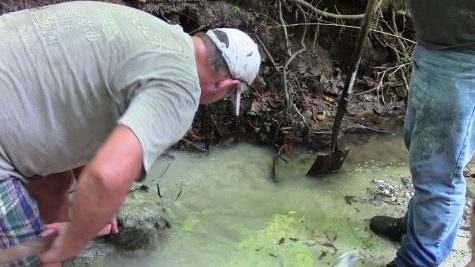Paleontology group delves into Georgia’s past
On Saturday, Sept. 22, 25 members of the Paleontology Association of Georgia (PAG) set out to the Sandersville area, two hours southeast of Decatur. Their mission: to collect fossils.
While the group included professional paleontologists, many of the attendees, such as Zachary Scott, were simply intrigued by the idea of collecting such archaic objects.
“Ever since I was a small child, I was always interested in anything old [like] antiques and shark teeth,” Scott said.
Others were still fascinated by the concept of what these fossils say about Georgia’s deep past.
“With these fossils we can recreate what the environment was like 35 million years ago,“ trip organizer Hank Josey said. “We know from what we’ve found here like oysters, sand dollars, shark teeth and manatees that this was some kind of near-shore environment.”
Regardless of their reasons for attending, all 25 gathered with Josey, who explained the ground rules and how to find certain fossils before leading them to the property where they would commence their search.
Once they had arrived with permission from the land’s owner and parked in a patch of tall grass separating the forest on either side, everyone sprayed down with bug spray and put on their water-resistant boots. After five minutes of walking through woods and brush, they arrived at the site: a creek that cuts through the fossil-bearing rock formations.
“The fascinating thing is that you can get out to either a road cut or on a river bank, or in this case today, a creek, and you’ll be able to find signs of ancient life that hasn’t been around for 35 million years,” attendee Mike Reagan said. “We’re probably hundreds of miles from the ocean.”

The paleontologists, experts and newcomers alike began chiseling sand dollars out of the rock, sifting sediments for shark teeth, and looking for any giant oysters that eroded out of the rock. It wasn’t long before everyone had gathered a collection of these ancient remains. Everything was carefully brought back to the cars bit by bit, saving the ancient specimens from the ravages of the weather.
The PAG, on the other hand, has had a brief history. Over 60 Georgians gathered in the Macon Museum of Arts and Sciences on Jan. 28, 2017 to create the organization for the study of Georgia’s paleontology. The last paleontology group in Georgia disbanded decades prior due to funding issues. The organization is currently healthy and drawing in new members from across the state, including Scott.
Scott joined the PAG just two weeks before the trip.
“Somebody sent us a link online and I just got to reading about it and some of the things they do,” Scott said. “I just thought it’d be something fun. So far, I’m having a great time.”
The PAG meets in or near Decatur from time to time. Their most recent meeting prior to this trip was held at Stone Mountain in August.

For more information on the PAG, check out their webpage: https://paleoassocga.weebly.com/
Contact the writer, Jared Dyche, at [email protected]
All photos by Jared Dyche.













